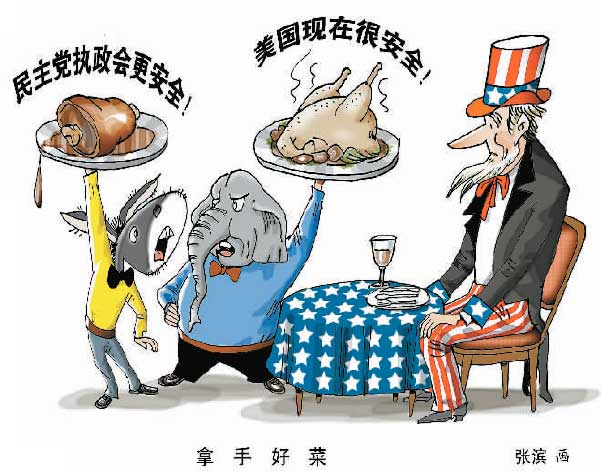(单词翻译:单击)
听力文本
Next topic then I'd like to go into is examining again at the national level
我们的下一个要研究的是从全国的范围来观察大选
And here we have the electoral college. We have how many electors come out of each state
我们要提到选举人团这个概念。每个州的选举人数是多少?
And we have the 2004 red blue map or on this case sort of wondrous brownish versus blue map. This is a Wikipedia map. Wikipedia has a lot of pretty good maps on this
我们来看看这幅04年的红蓝地图,看起来更像一幅棕蓝色的地图这是维基百科上的地图,维基百科上有很多关于选举的好地图
So here's the same map we've been looking at all along
回到这幅我们一直在分析的图
One interesting thing to look at is we've looked at it geographically. Let's look at it historically how long has this pattern been around
有意思的是刚才我们一直在分析其地理特征,让我们从历史的角度分析这样的红蓝布局形成多久了呢
Is it very deep historically? No, not at all, it really
是否很久以前就已出现这种分布?并不是,
the earlier the most recent election before 2004. The 2000 election was quite similar
最接近04年的总统大选也就是2000年的大选,有相似的布局
We go earlier than that we don't see the same pattern at all
但再往前追溯,我们就看不到相似的红蓝分布了
And in fact a lot of the patterns we see today that seem so stark didn't exist 20 years ago
事实上现在我们看到的分布看起来虽然明显,但形成才不到20年
The 1988 election, George Bush Senior, Michael Dukakis religious differences play almost no role in that election, maybe a few percent
在77年老布什和杜卡基斯的角逐中,宗教差异几乎完全不重要,可能只影响几个百分点,
and it really started in the 90s the difference between the more religious and more secular voters and areas and seems to be intensified
但从90年代开始,信教区的选民和非信教区的选民差异开始深化
But we're not talking about a very deep pattern
我们所说的红蓝分布并不是一定的或绝对的

And I'll just show you a few historical maps, so we will be spending a lot of time
我会用几幅历史上大选的地图作对比,我们在这上面花些时间
You can switch back and forth between these and we can see some changes, so we can see Iowa going from Democratic to Republican, same with New Mexico
在这两年的地图间来回切换,我们会发现一些变化,爱荷华从支持民主党转向了共和党,新墨西哥也是如此
These are states right on the edge
这都是些摇摆不定的州
We can see New Hampshire doing the opposite
新罕布什尔州则转向相反
You can also as you flip back and through this, look at the electoral votes, look at Florida and Texas
通过两幅图前后对比,你会发现一些州选举人票数量有变,如佛罗里达州和德州
Look at Michigan and see Pennsylvania, 17,18 or they lost one, Pennsylvania 21,23 they lost two
密歇根州和宾州,密歇根州从18票变为17票,比上届少了一个选举人票,宾州则从23票变为21票,少了2票
So the electoral college changes as population changes
各州选举团人数随着人口变化而变化
And it has been the more republican voting areas had been gaining electoral seats
一些共和党支持州的选举人票数在增多
And a lot of these Democratic states in the northeast losing them
一些东北部支持民主党的州票数在减少
That's of course Republican partisans are very happy about and Democratic partisans are worried about
共和党人无疑会对此感到高兴,民主党人则为此忧心忡忡
视频及简介
本课程结合大量地图,探索了美国总统大选(包括过去和现在)中的地理学,并且对仅仅简单把美国分为红州(共和党)和蓝州(民主党)这一说法提出挑战。现实中,美国社会两党的情况,远比这种简单的两分法要复杂。


